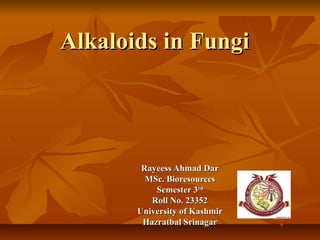
Alkaloids in fungi
- 1. Alkaloids in Fungi Rayeess Ahmad Dar MSc. Bioresources Semester 3rd Roll No. 23352 University of Kashmir Hazratbal Srinagar
- 2. Alkaloids Alkaloids are the cyclic organic compounds in which nitrogen forms a part of the cycle system and are physiologically active as poisons and drugs.
- 3. Alkaloids are mostly produced by plants. However, some are derived from bacteria, fungi, animals. Synthesized from amino acids.
- 4. Classification 1. True (Typical Alkaloids): Derived from amino acids and have nitrogen in a heterocyclic ring. Atropine. 2. Protoalkaloids: Derived from amino acids and do not have nitrogen in a heterocyclic ring. Ephedrine. 3. Pseudo alkaloids: Not derived from amino acids but have nitrogen in a heterocyclic ring. Caffeine. 4. False alkaloids: Non alkaloids which give false positive reaction with alkaloidal reagents.
- 5. Main Functions They act as protective agents against insects, herbivores due to their bitterness and toxicity. So, they can be used as biopesticides and bioinsecticides. They also act as a source of nitrogen in case of nitrogen deficiency. Many of them have medicinal properties.
- 6. Some of the Alkaloids present in Fungi
- 7. Alkaloids From Ergot Fungi Ergot fungi belong to the Claviceps genera. These fungi affect rye (mostly), wheat, barley. The fungi produce alkaloids such as Ergotamine, Ergometrine, Ergonaline and various other Clavine alkaloids. Has the biological activity as vasoconstrictors.
- 8. Ergotamine It has the biological activity as a vasoconstrictor. It is used medicinally for the treatment of acute migrain attacks (sometimes in combination with caffeine). It has been used to prevent post-partum hemorrhage (bleeding after child birth). It was first isolated by Arthur Stoll in 1918.
- 9. Methergin is the brand name of the drug that has been derived from Ergot and is used to stop post natal bleeding
- 10. ergotamine Ergot on rye
- 11. However, high doses of ergot alkaloids or taking the infected grains lead to Ergotism. It is characterized by spasms, diarrhea, head aches, vomiting etc.
- 12. Loline alkaloids These are insecticidal and insect-deterrent compounds. These are produced in grasses infected by endophytic fungal symbionts of the genus Epichloe and Neotyphodium. First isolated from the grass Lolium temulentum.
- 13. Psilocybin Produced by about 200 species of mushrooms collectively called psilocybin mushrooms (such as Psilocybe azurescens, P. cyanescens and a number of other genera). When ingested, psilocybin is turned into psilocin within the body, which in turn is responsible for hallucinations, changes in perception, a distorted sense of time and can include possible adverse reactions such as nausea and panic attacks.
- 14. Psilocybe azurescens - Flying Psilocybe cyanescens Saucers
- 15. Oxaline Derived from Penicillium oxalicum, which usually grows on dead and decaying matter. This alkaloid was found to arrest the cell cycle by inhibition of tubulin polymerisation.
- 16. Penicillium rot caused by Penicillium oxalicum in the corn
- 17. Paramine Produced by some grass infecting Neotyphodium species. The alkaloid protects the grass againest grazing by mammals and insects. This alkaloid can also be used as bioinsecticide and biopesticide.
